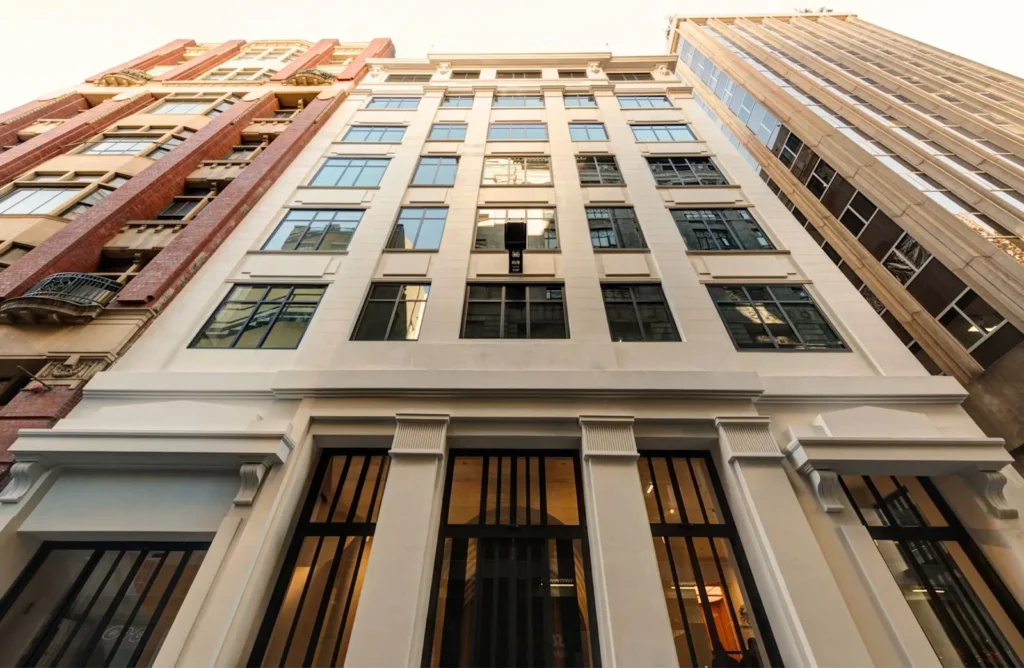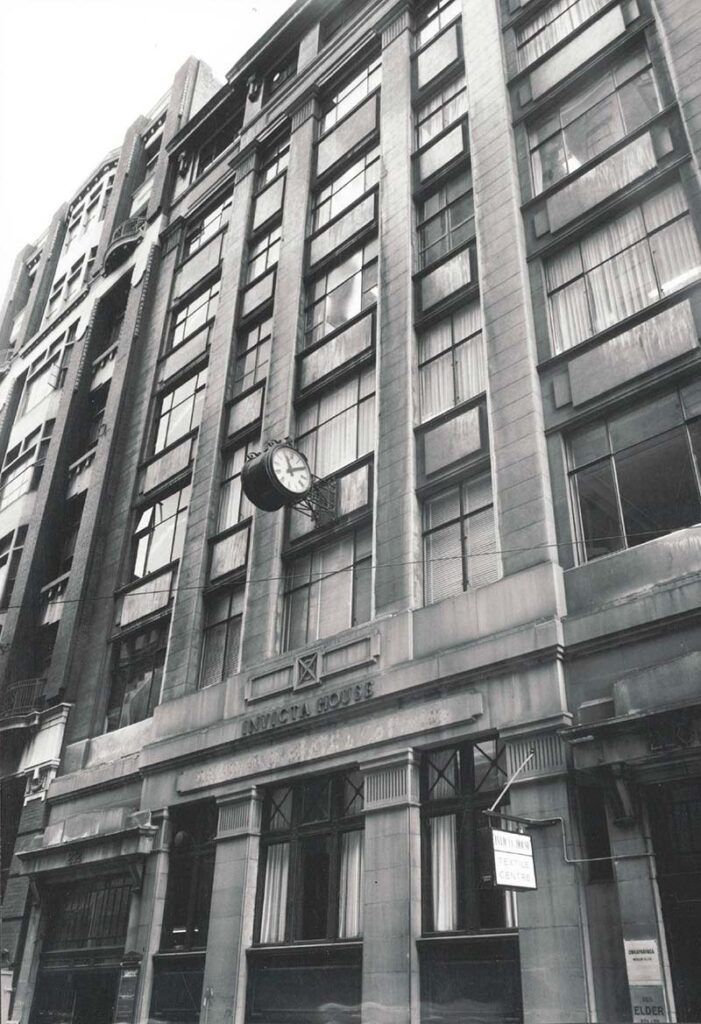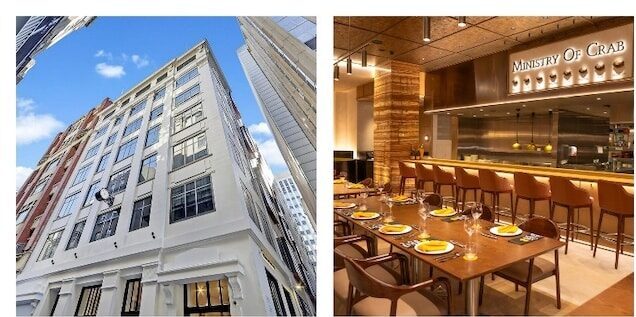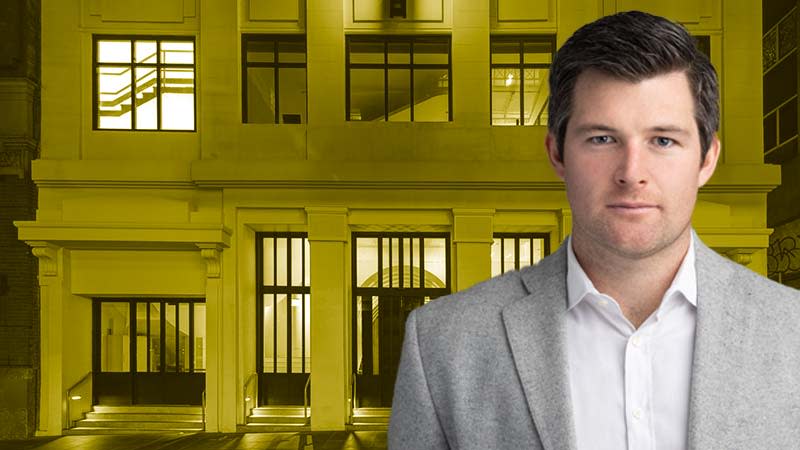Source: The Urban Developer
Author: Leon Della Bosca
Date: 18 June 2025
“It is possible,” says Plus Architecture director Ian Briggs of heritage adaptive reuse projects.
The transformation of a century-old Melbourne building—from silk merchant to police station, backpackers’ accommodation to premium commercial space—proves his point.
The successful conversion of Invicta House demonstrates how heritage buildings can deliver viable returns when developers combine careful planning with experienced design teams and flexible funding structures.
ST Real Estate (STRE) completed the $30-million redevelopment of the eight-storey building at 226 Flinders Lane in May, creating more than 5000sq m of net leasable area after adding two floors to the heritage structure.

Melbourne Lord Mayor Nicholas Reece, who officially opened Invicta House, says “retrofitting and revitalising buildings in the CBD is a win-win for everyone” that maintains heritage streetscapes while adding premium commercial space.
The project aligns with the City of Melbourne’s Retrofit Melbourne initiative and Adaptive Reuse for Office Buildings guidelines.
The partnerships between Plus Architecture, STRE and Zagga was key to the success.

It is possible: Plus director Ian Briggs and STRE managing director Patrick Lardi.
The four-year development is the latest collaboration between STRE and Plus Architecture, building on their previous heritage work together.
Location was fundamental to the project’s viability.
STRE managing director Patrick Lardi says the building “ticks all the boxes on location”.
“The site [has] major infrastructure projects coming along, the station was already there, it’s in a good spot in the middle of the CBD, very close to Collins but not on Collins,” Lardi tells The Urban Developer.
“And it’s on Flinders Lane, which is quite famous in Melbourne and beyond.”
Being so close to the future Town Hall Station creates significant tenant value, allowing businesses to secure prime CBD location advantages while avoiding the higher rents commanded by Collins Street.
STRE acquired the property, completed in 1926, for $37 million in 2021 after initially losing out to Swinburne University in 2018 when the university outbid them with $44 million against STRE’s $42 million offer.
When Swinburne’s plans changed and the property returned to market during the pandemic, STRE secured it for $5 million less than its original unsuccessful bid.
“I think it was probably one of the best buys I made,” Lardi says. “I’d already moved on and had my heritage building project in Melbourne, so I could stick to my target price on 226.”
The $30-million investment reveals the cost realities of heritage projects.
Lardi estimates heritage preservation work, including reinstalling original mouldings and structural compliance upgrades, took about a third of the budget, while base building services and premium fitouts each accounted for another third.
Briggs approached the project by recognising that the accumulated layers from the building’s 100-year history required careful editing rather than wholesale preservation.
“The process was actually reinstating rather than restoring lost heritage wherever possible,” Briggs tells The Urban Developer.
“This is a broader challenge for any refurbishment of old buildings—maintaining the quality and uniqueness that a period building has while bringing it up to code.
“From day one, you start changing the building to bring it up to code but also try to take it back at the same time.”
Zagga director Tom Cranfield says the location, infrastructure and experienced team made the decision attractive.
Cranfield tells The Urban Developer Zagga was “supportive of the concept of activating buildings through adaptive reuse”.

View from the street: The century-old Invicta House in an image by eminent Australian photographer Wolfgang Sievers from 1968.
“A big reason why we were able to support their strategy is because they are a big group with lots of experience, assets, and capability,” he says.
“One of the attractions for us taking on this asset is the future of Town Hall Station on Swanston Street.”
The funding structure required higher equity contribution and contingencies than typical developments but enabled STRE to complete fitouts before leasing, allowing tenants to experience finished spaces rather than construction sites.
The building’s heritage constraints became selling points. Four-metre ceiling heights exceed typical modern developments, while the central light well and bay windows maximise natural light penetration, targeting the sub-1000sq m floor plate market where tenants increasingly seek completed fitout spaces.
Central to the building is a sculptural staircase inspired by the site’s silk trading history.
Briggs designed the fluid structure to reference “the rolls of fine silk once traded from this site” while providing practical access to three separate entrances.
“On one level it’s a big showy statement, but at another level it has deep roots to the building specifically,” Briggs says.
“It’s not just an architectural flourish I dreamed up—it’s a meaningful addition that talks to its past and to the future while addressing really technical issues.”



The project required careful navigation of heritage approvals for contemporary interventions including the two-storey rooftop addition.
“For the roof extension, we had to set back the two-storey addition so it’s not visible from the footpath,” Briggs says.
The design team worked from original architectural drawings of 1926 to reinstate elements including the facade clock, and also introduced new features such as bay windows projecting into the service lane.
Development complexities also included changing legislation during construction.
“There was major deviation on code compliance for fire safety, earthquake stability, and so on,” Lardi says.
“To complete the perfect storm, we started in the middle of the pandemic with supply chain issues, labour shortages, inflation.”
The project’s success may provide valuable lessons for other developers considering heritage adaptive reuse. Lardi particularly emphasises thorough upfront investigation.
“Invest enough time—even more time than we invested—in the discovery and planning phase. You cannot assume.
“Even if you find old blueprints, measure again because it’s not guaranteed they were built exactly to blueprint.”

Zagga director Tom Cranfield: “Would definitely do it again.”
From an architectural perspective, Briggs stresses the importance of experienced teams.
“Use somebody who’s already done it. Use a builder who’s already done it, use an architect who’s already done it, so you’re not paying for the entire learning curve.”
The partnership’s record has attracted continued backing from Zagga, which sees potential for expanding the adaptive reuse model.
“We would be happy to take on more of that,” Cranfield says. “One of the challenges for the market is how do you convince groups that are as high quality as STRE to take on more of these types of buildings?
“We’ve done it more than once and would definitely do it again.”
STRE reports consistent inspection activity since completion in May, with 38 per cent of one floor already leased.
The company expects cash-positive returns within 12 to 18 months.
Looking beyond financial returns, Lardi reflects on the project’s broader contribution to Melbourne’s urban fabric.
“I think we’re helping the city retain its character, and we’re helping activate Flinders Lane without interfering too much with what’s already there.”
Briggs believes the project demonstrates broader possibilities for Melbourne’s heritage building stock.
“Being able to bring this historic building back to all the good parts of its original character, while also adding a new chapter to its life,” he says.
“Projects like this at one end of the spectrum, and 1980s-1990s office buildings at the other, are being used as exemplar projects to help inform other developers that it is possible.”




